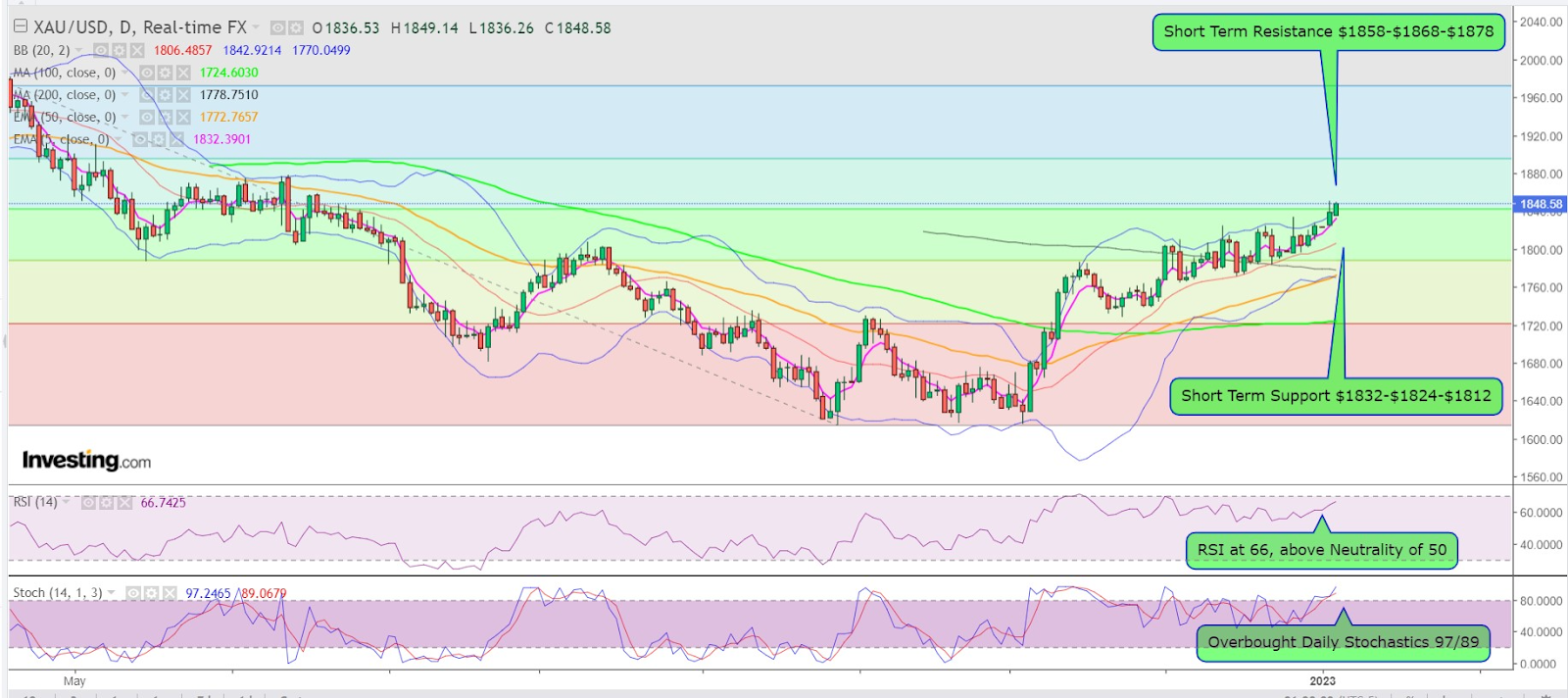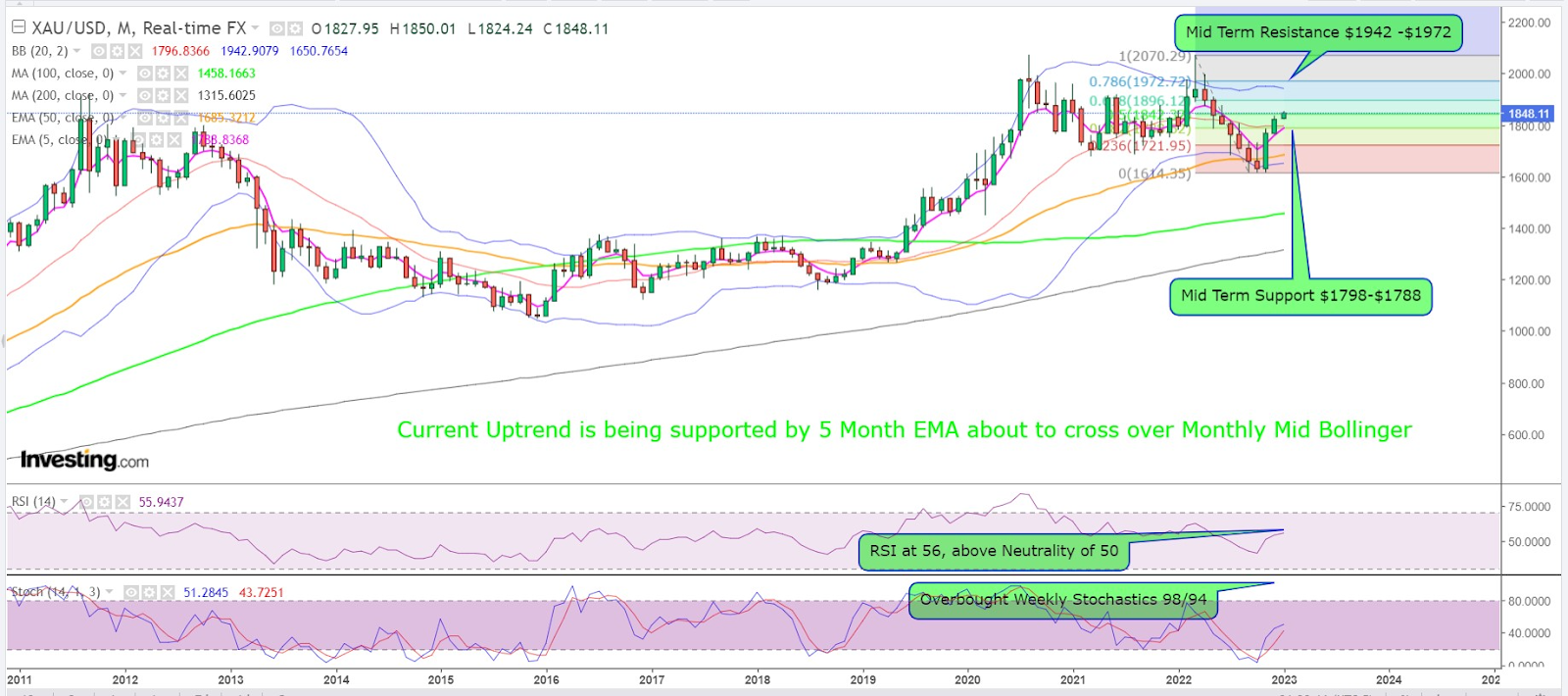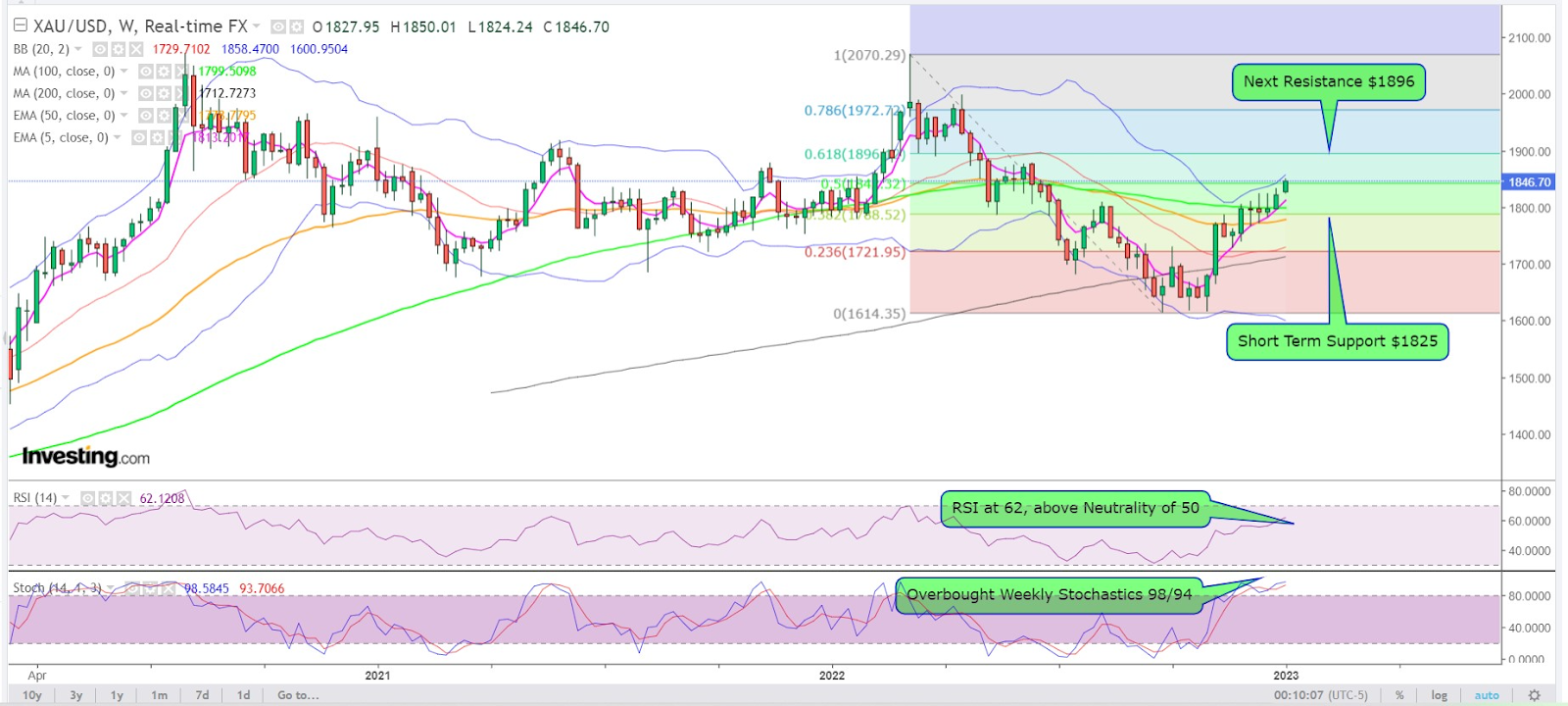- Gold has markings of a runaway market as recession fears empower safe-haven
- Charts show $1,950/oz could still be major resistance through the first quarter
- In the near-term, aggressive selling below $1,850 could lead to a low of $1,798
Commodity strategists have already proclaimed it: Gold’s new record will be this year.
But technical charts show that $1,950 an ounce could still be a major resistance for the yellow metal, and that could prevail through the first quarter, meaning a new all-time high could be three months away. Charts by SKCharting.com, with data powered by Investing.com
Charts by SKCharting.com, with data powered by Investing.com
Fundamentally, gold has all the makings of a runaway market.
The new year has brought along new ominous warnings of a recession that catapulted gold to a near seven-month peak of above $1,850 an ounce as trading for 2023 entered its first day on Tuesday.
The International Monetary Fund said the world’s three main growth centers — the United States, Europe, and China — were all experiencing weaker activity as 2023 began, raising the stakes for a global economic slowdown.
Chinese manufacturing activity particularly shrank for a fifth straight month in December, a private survey showed on Tuesday, as the world’s second-largest economy grappled with an unprecedented spike in coronavirus cases after it relaxed some restrictions intended to prevent the spread of the virus.
The figures provide a snapshot of the challenges faced by Chinese manufacturers who now have to contend with surging infections after the country’s abrupt COVID policy U-turn in early December.
President Xi Jinping recently said China’s economy grew by 4.4% in 2022 - a figure much higher than markets anticipated. But he also noted increased pandemic-related headwinds for the economy in the coming months.
Craig Erlam, an analyst at online trading platform OANDA, wrote in his note on gold on Tuesday:
“Gold is rallying strongly … and gathering momentum. This could be a year in which global growth slows significantly, and traders are questioning whether that will warrant monetary policy to be loosened later in 2023. Central banks have pushed back strongly against the idea, and I imagine the IMF would too at this point, but we could see markets moving in that direction if the data doesn’t continue to haunt us.”
Much of the 2023 outlook for global markets hinges on the trajectory of monetary policy as central banks consider pivoting from the aggressive interest rate hikes of the past year amid slowing economic growth.
Still, economists are divided as to whether this will culminate in rate cuts by the end of the year, with inflation expected to remain well above the target range in most major economies.
In the United States, all focus is on Friday’s U.S. nonfarm payrolls report for December. The jobs report is the first top-tier release of 2023 before next week’s more important Consumer Price Index, or CPI, report.
The report is critical as the Federal Reserve faces a dilemma on whether to keep up with monetary tightening to get inflation to its preferred level or let up on aggressive rate hikes to shield the economy from a slowdown. Higher inflation and rising interest rates have hit the housing sector – and could next hit the labor market, which has shown stupendous growth for the past two years since the world came off the worst of the pandemic. On the other hand, eight nonfarm payrolls reports have exceeded economists’ estimates, so another positive surprise cannot be ruled out.
Economists expect an increase of 200,000 jobs in December, which would be lower than the 263,000 reported for November but still extremely healthy by U.S. labor market standards. Before the pandemic, American jobs grew by just under 200,000 a month.
In order to see salary growth cooling, “the labor market would need to expand at a pace of under 100,000 or even suffer job losses”, said Yohay Elam, an analyst at FXStreet.
“In such an ‘as-expected’ scenario, markets would wobble, and the U.S. dollar could gain some ground in response to uncertainty about the Fed’s next moves. The greenback attracts safe-haven flows. However, many investors would likely keep their powder dry ahead of next week’s all-important CPI report.”
Gold’s rally on Tuesday came despite a rebound in the dollar, further underscoring the relative strength of the yellow metal. The Dollar Index and U.S. Treasuries benchmarked to the 10-year note are basically contrarian trades to gold. When these two decline on concerns related to economic growth or disinflation, gold tends to rise as a safe haven.
All eyes are now on gold, the dollar, and U.S. Treasuries as traders try to figure out the Fed’s rate hikes for this year. The central bank is widely expected to raise rates by 25 basis points when it meets in February amid increasing signs that U.S. inflation has peaked. Last year, the Fed raised rates by 425 basis points in all.
A full dovish pivot by central banks this year would likely have major implications for gold prices, according to strategists.
Ole Hansen, Head of Commodity Strategy at Saxo Bank, said in comments carried by CNBC:
“In general, we are looking for a price friendly 2023 supported by recession and stock market valuation risks — an eventual peak in central bank rates combined with the prospect of a weaker dollar and inflation not returning to the expected sub-3% level by year-end — all adding support. In addition, the de-dollarization seen by several central banks last year when a record amount of gold was bought look set to continue, thereby providing a soft floor under the market.”
Gold prices have been on a general incline since the beginning of November as market turbulence, rising recession expectations, and more gold purchases from central banks underpinned demand.
This year would likely see a “new secular bull market” for gold, with prices exceeding $2,100, said Eric Strand, manager of the AuAg ESG Gold Mining ETF. He adds:
“Central banks as a group have continued, since the great financial crisis, to add more and more gold to their reserves, with a new record set for [the third quarter of] 2022.
It is our opinion that central banks will pivot on their rate hikes and become dovish during 2023, which will ignite an explosive move for gold for years to come. We, therefore, believe gold will end 2023 at least 20% higher, and we also see miners outperforming gold with a factor of two.”
Juerg Kiener, managing director, and chief investment officer at Swiss Asia Capital, concurs with Strand. “It is not going to be just 10 or 20%,” Kiener said, referring to the gold rally for 2023. “I think I’m looking at a move that will really make new highs.”
Technical charts for spot gold, which is more closely followed than futures by some traders, however, suggest that $1,950 may be a firm interim stop through the first quarter. Spot gold hit a near seven-month high of $1,850.01 on Tuesday.
Says Sunil Kumar Dixit, chief technical strategist at SKCharting.com:
“Spot gold needs to stabilize at above $1,950. It might seem like a no-brainer — in order to get to a new record above $2,000, you’d need to cross $1,950.
But the reality is it is actually a structurally-important level for gold to consolidate and gain strength at in order for it to make the next leap towards a record. It’s not just a natural progression. That stabilization at above $1,950 is key. And so far, that level appears to be a resistance.”

Considering that key Fed rates usually peak in the second quarter, and with a potential recession looming along with signs of a worsening sequel of China’s pandemic, “it won't be surprising if gold reaches and stabilizes above $1,950 over the mid-term, like the second quarter”, said Dixit.
He gives another reason why spot gold needs to hold at above $1,950 before making a record.
“For quite a long time, $1,920 was the record high for spot gold, before the advent of $2,073 in August 2020, which was almost matched dollar for dollar by the March 2022 peak of $2,070.”

In the near-term, spot gold’s weekly stochastics at 98/94 indicate overbought conditions calling for a temporary rebalancing and correction toward support areas, Dixit said.
“As long as prices sustain below $1,850, spot gold is likely to crawl downward retesting the previous week's close of $1,824.”
“If spot gold breaks below 1,824, expect a retest of the 5-week EMA of $1,813, followed by the 100-week SMA of $1,798,” he said, referring to the Exponential Moving Average and the Simple Moving Average markers.
“As the trend has turned bullish, any correction towards the support zone is very likely to attract buyers and the rally can resume towards advanced levels of $1,868-$1,878, followed by an interim resistance at $1,896.”
He added that the current bullish rebound was being supported by the 5-month EMA, which was about to cross over to the monthly Middle Bollinger level.
Disclaimer: Barani Krishnan uses a range of views outside his own to bring diversity to his analysis of any market. For neutrality, he sometimes presents contrarian views and market variables. He does not hold positions in the commodities and securities he writes about.
